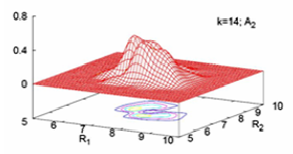Theoretical Study of the Rovibrational Spectra of Argon Trimer
Abstract
The Ar3 system has been studied by means of an exact quantum mechanical variational method based in the use of distributed Gaussian functions to describe the interparticle Ar-Ar distances. This work includes the rovibrational levels spectra for the zero total angular momentum, J=0, case and for J=1. In order to describe the rotational part, we have used an approximate method in which the eigenfunctions obtained in the purely vibrational problem are employed in the solution of the J > 0 case. Besides the energy levels, rotational constants have been calculated. Different approaches for the calculation of such constants are comparatively analysed.

This work is licensed under the Creative Commons Attribution-NonCommercial 4.0 International (CC BY-NC 4.0) license.








